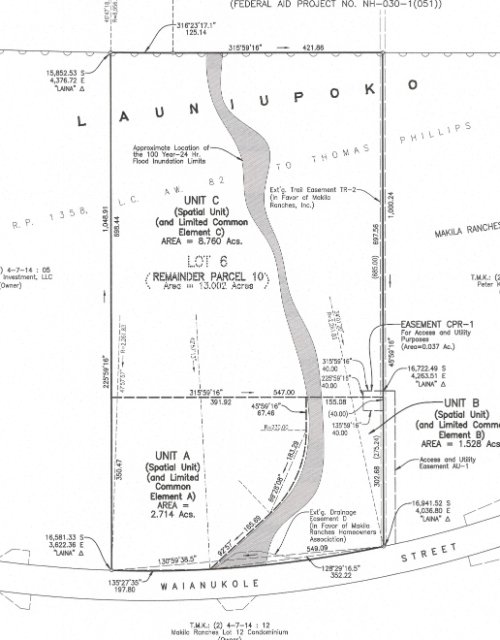What is a CPR?
A CPR (Condominium Property Regime) in Hawaii is a method of property ownership where a single plot of land or a building is divided into multiple, individually owned units or lots. For example, an developer may “condominiumize” a lot and divide the property into 3 major components, the main house “A Unit”, the cottage “B Unit”, and the agricultural “C Unit.” Each unit will have exclusive use of their limited common element but will remain one lot in the eyes of the county planning dept.
Property Taxes
Each unit gets its own Tax Map Key (TMK) number, deed, property taxes, and is treated as a separate piece of real property.
Benefits and Uses of CPR in Hawaii:
Subdivision Alternative: When traditional subdivision isn’t feasible, CPR allows landowners to sell portions of their property. This is particularly useful on agricultural land like Launiupoko, Olowalu, or Haiku where despite zoning restrictions, you can build a main dwelling, an Ohana (cottage up to 1,500 sq.ft.), farm buildings such as a barn, as well as other amenities such as pool, spa, and a cabana.
Financial Opportunities: Owners can sell individual units, making it lucrative for those with land in high-demand areas like Launiupoko where an Ohana might sell for between $1.5M to over $3M with a unit with ocean view.
Challenges and Considerations:
Condo Association Rules: Even CPR properties might have an association with rules and restrictions, potentially more stringent than local laws, which can affect what you can do with your property such as pet restrictions.
Maintenance and Fees: While some CPR properties might not have monthly dues unless part of a larger HOA, others might, particularly if there are shared common elements to maintain. On the contrary, you may want to have a rainy day fund to repave a common driveway and you will need cooperation from the neighboring unit(s) to contribute to this fund.
Non-conforming dwellings
The county planning dept recognizes a CPR as one lot which means all units must be conforming in order to pull new permits for future modifications. Let’s say Unit A wants to add a bonus room and applies for a permit with the county. Upon an inspection, it is discovered that Unit B has added an outdoor shower and enclosed the carport for additional living area. Unit A’s plan maybe negatively impacted because of Unit B’s unpermitted modifications.
Water fixture count limits:
The primary determinant of how many water fixtures you can have on your property is the size of your water meter. For instance, a common 5/8-inch meter typically allows for up to 31 water fixture units in Maui County. Each type of fixture (like sinks, toilets, bathtubs, washing machines, etc.) counts differently towards this limit. For example, a low-flow toilet might count as 1.7 fixture units, while a regular toilet might count as 3. Typically it is predetermined how the water fixtures are divided up amongst the units. The main home may get 20 fixture counts and the cottage may get 11.


